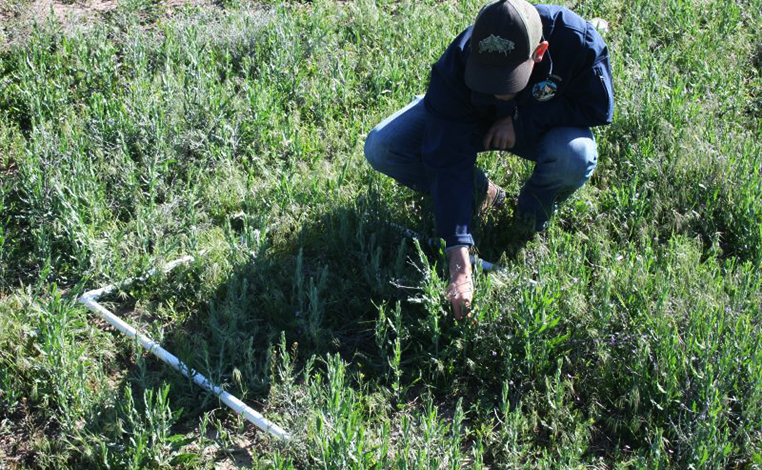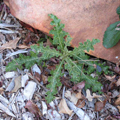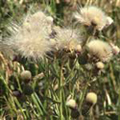Canada Thistle
Cirsium arvense (L.) Scop.
Keys to Identification
This information courtesy of the Colorado Natural Areas Program
Family
Asteraceae (Sunflower)
Other Names
Field Thistle, Californian Thistle
USDA Code
CIAR4
Legal Status
Colorado Noxious Weed List B
Identification
Lifecycle
Perennial
Growth form
Forb
Flower
Flower heads are purple and borne in clusters of 1-5 per branch. Heads are only about 3/4 in wide. June-Oct.
Seeds/Fruit
One-seeded fruits (achenes) are straw or light brown, straight or slightly curved (Moore 1975).
Leaves
Leaves are spiny, alternate, oblong or lance-shaped, with the base leaves stalkless and clasping, or extended down along the stem.
Stems
Mature plants range from 2-4 ft tall.
Roots
Canada thistle has two types of roots, horizontal and vertical. The horizontal roots produce numerous shoots, while vertical roots store water and nutrients in their many small branches.
Seedling
Early spring growth appears as rosettes with spiny-tipped, wavy leaves.
Other
The floral bracts of Canada thistle are spineless.
Similar Species
Exotics
Bull thistle(Cirsium vulgare); flower bracts are somewhat tapered and covered with spines. Scotch thistle(Onopordum acanthium); stems appear the have wings, floral bracts are covered with spines. Plumeless thistle(Carduus acanthoides); floral bracts are covered with sharp spines. Musk thistle(Carduus nutans); floral bracts are broad with spiny tips.
Natives
Wavyleaf thistle(Cirsium undulatum); flower bracts often have a prominent white glandular dorsal ridge (often sticky to touch) and minutely hairy margins (Whitson et al. 1996). Leafy thistle(Cirsium foliosum); the leaves surrounding the terminal flowers are pink to white. Yellowspine thistle (Cirsium ochrocentrum); flower bracts are covered with cobweb-like hairs and have a spreading yellow spine at the tip.
Impacts
Agricultural
Canada thistle is an aggressive, creeping, perennial weed. It infests crops, pastures, rangelands, roadsides, and riparian areas (Beck 1996).
Ecological
Canada thistle spreads rapidly through horizontal roots, which give rise to shoots (Moore 1975). Its root system can be extensive, growing horizontally as much as 18 feet in one season (Nuzzo 1998). Most Canada thistle patches spread at a rate of 3-6 feet/year, crowding out more desirable species and creating thistle monocultures.
Human
Spiny thickets of Canada thistle can restrict recreational access to infested areas.
Habitat and Distribution
General requirements
Canada thistle thrives in the Northern Temperature Zone due to its day length response and a high temperature limitation on growth (Haderlie et al. 1991). Although Canada thistle mainly invades disturbed areas, it does invade native plant communities, open meadows (including wetlands), and ponderosa pine savanna (Rutledge and McLendon 1998). Canada thistle is adapted to a wide range of soil types and environmental conditions (FEIS 1998). It is best adapted to rich, heavy loam, clay loam, and sandy loam, with an optimum soil depth of 20 inches (FEIS 1998, Rutledge and McLendon 1998). Canada thistle can tolerate saline soils (up to 2% salt) and wet or dry soil (Rutledge and McLendon 1998). However, it does not tolerate waterlogged or poorly aerated soils. Canada thistle usually occurs in 17-35 in annual precipitation zones or where supplemental soil moisture is available (Beck 1996).
Distribution
Canada thistle is common found along roadsides, fields, pastures, meadows, and other disturbed areas statewide in Colorado (FEIS 1998, Rutledge and McLendon 1998). In Colorado, Canada thistle is typically found from 4,000-9,500 feet. Canada thistle is found throughout the northern half of the United States and lower portions of Canada.
Historical
Canada thistle is a native of southeastern Eurasia. It was introduced to Canada as a contaminant of crop seed as early as the late 18th century. Since its introduction, it has spread throughout North America (Whitson et al. 1996).
Biology/Ecology
Life cycle
Over-wintering roots develop new underground roots and shoots in January and begin to elongate in February (Nuzzo 1998). Shoots emerge between March and May, when mean weekly temperatures reach 5° C, and form rosettes (Nuzzo 1998). Early in the spring, plants remain near the soil surface until long days (over 14 hours of light) trigger flowering and stem elongation (Haderlie et al. 1991, FEIS 1998). Canada thistle is dioecious (male and female flowers are produced on separate plants). Female flowers can be readily distinguished from male flowers by the absence of pollen (abundant in male flowers) and presence of a distinct vanilla-like fragrance. Flowering occurs from June to October in Colorado (Rutledge and McLendon 1998). Seeds mature July to October.
Mode of reproduction
Canada thistle reproduces primarily vegetatively through creeping horizontal roots, and can quickly form dense stands. Every piece of the root system is capable of forming a new plant (Rutledge and McLendon 1998). This allows dense monocultures of Canada thistle to form even without seed production. Canada thistle growth is limited or stopped when temperatures exceed 30° C for extended periods of time. Canada thistle is also shade intolerant. It can grow along the edge of forested areas, but is rarely found within forests.
Seed production
A female Canada thistle plant can produce up to 5,200 seeds in a season, but the average is about 1,500 seeds/plant (Rutledge and McLendon 1998). Most seeds drop near the plant and only the seedless plumes are dispersed by the wind.
Seed bank
Mature seeds germinate most readily in mid-spring. Seeds that do not germinate may remain dormant for several years but most studies indicate that the majority of seeds do not remain viable after three years of burial (Rutledge and McLendon 1998).
References
Beck, G.K. 1996. Natural resources series, Canada thistle. Colorado State University Cooperative Extension. Internet 11/6/98: Availble:http://co.jefferson.co.us/dpt/openspac/weed/canthstl.htm
FEIS – Fire Effects Information System [Online] (1996, September). Prescribed Fire and Fire Effects Research Work Unit, Rocky Mountain Research Station (producer), US Forest Service. Available: www.fs.fed.us/database/feis/ [1998,March 12]
Haderlie, L.C., R.S. McAllister, R.H. Hoefer, P.W. Leino and L.F. James (Ed.). 1991. Noxious Range Weeds. Boulder: Westview Press. pp. 260-263.
Moore, R.J. 1975. The biology of Canadian weeds. 13. Cirsium arvense (L.) Scop. Canadian Journal of Plant Science. 55:1033-1048.
Nuzzo, V. 1998. Element stewardship abstract for Cirsium arvense. The Nature Conservancy. Internet 10/16/98. Available: http://tnc.weeds.ucdavis.edu/esadocs.html
Rutledge, Chris R. and Dr. Terry McLendon. No Year. An Assessment of Exotic Plant Species of Rocky Mountain National Park. Department of Rangeland Ecosystem Science, Colorado State University. 97pp. Northern Prairie Wildlife Research Center Home Page. http://www.npwrc.usgs.gov/resource/othrdata/explant.htm (Version 15DEC98).
Whitson, T.D.(ed.), L.C. Burrill, S.A. Dewey, D.W. Cudney, B.E. Nelson, R.D. Lee, R. Parker. 1996. Canada thistle. Weeds of the West. Western Society of Weed Science, in cooperation with the Western United States Land Grant Universities Cooperative Extension Services, Newark CA. pg. 109.




